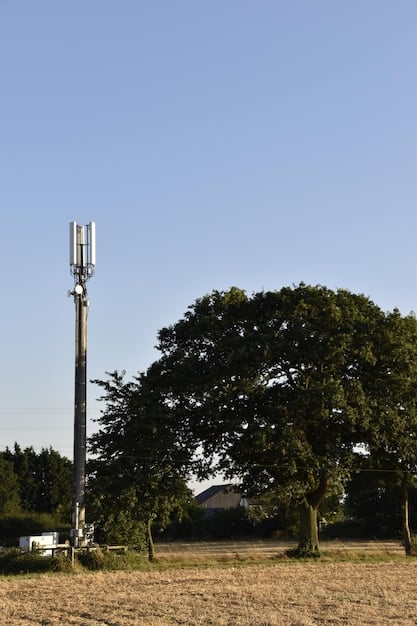5G Expansion: Bridging the Rural Broadband Gap with the Infrastructure Bill

The 5G expansion, accelerated by the latest infrastructure bill, promises to significantly enhance rural broadband access by allocating substantial funds for deployment and bridging the digital divide, ensuring equitable access to high-speed internet for all Americans.
The promise of 5G expansion has long been on the horizon, particularly for rural communities often left behind in the digital revolution. The latest infrastructure bill aims to change that, injecting much-needed resources to bridge the digital divide and bring high-speed internet access to underserved areas. What exactly does this mean for rural broadband, and how will it impact the lives of those who stand to benefit?
The Current State of Rural Broadband Access
Rural communities in the US have historically faced significant challenges in accessing reliable, high-speed internet. This digital divide has far-reaching implications, affecting everything from education and healthcare to economic development and quality of life.
The Digital Divide: A Persistent Problem
Limited infrastructure, sparse populations, and challenging terrain have made it difficult and expensive for internet service providers (ISPs) to extend broadband services to rural areas. This disparity has created a significant divide between urban and rural connectivity.
The consequences of this digital divide are profound. Students in rural areas often lack the internet access needed to complete homework and participate in online learning. Healthcare providers struggle to offer telehealth services, limiting access to care for those who need it most. Businesses in rural communities are at a disadvantage, unable to compete in an increasingly online economy.
Key Statistics Highlighting the Disparity
Statistics paint a stark picture of the state of rural broadband access. According to the FCC, a significant percentage of rural Americans lack access to broadband internet compared to their urban counterparts.
- A study shows that approximately 25% of rural Americans lack access to broadband internet, compared to only 2% of urban residents.
- The average download speeds in rural areas are often significantly lower than those in urban centers, hindering online activities.
- The lack of reliable internet access has been linked to lower educational attainment, reduced job opportunities, and limited access to healthcare services in rural communities.
The current state of rural broadband access underscores the urgent need for comprehensive solutions, and the infrastructure bill represents a significant step towards addressing this critical issue. Closing this digital divide is essential for ensuring equitable opportunities and fostering economic growth in rural America.
The Infrastructure Bill: A Game Changer for 5G Expansion
The infrastructure bill, officially known as the Infrastructure Investment and Jobs Act, represents a historic investment in America’s infrastructure, including a significant allocation for broadband expansion and digital equity. This funding aims to bridge the digital divide and bring high-speed internet to all Americans, with a particular focus on rural and underserved communities.
Key Provisions for Broadband Expansion
The bill includes billions of dollars specifically earmarked for broadband deployment, subsidies for low-income households, and initiatives to promote digital literacy. These provisions are designed to address the multifaceted challenges of rural broadband access.
The bill allocates a substantial amount to states for broadband infrastructure projects, prioritizing areas with the greatest need. It also establishes a permanent program to help low-income families afford internet service, ensuring that cost is not a barrier to access.
How the Funding Will Be Distributed
The funding will be distributed through a combination of grants, loans, and other financial mechanisms, with states playing a central role in identifying and prioritizing projects. The goal is to ensure that the funding is used effectively and efficiently to achieve the greatest impact.

- States will be responsible for developing broadband deployment plans, identifying unserved and underserved areas, and awarding grants to ISPs and other entities.
- The FCC will play a role in overseeing the distribution of funds and ensuring compliance with federal regulations.
- Community anchor institutions, such as schools, libraries, and healthcare facilities, will also be eligible for funding to improve their broadband infrastructure.
The infrastructure bill’s broadband provisions represent a transformative opportunity to close the digital divide and bring the benefits of high-speed internet to all Americans, particularly those in rural communities. By addressing the key barriers to access, this bill aims to create a more connected and equitable society.
5G Technology: A Potential Solution for Rural Areas
5G technology holds significant promise as a solution for expanding broadband access in rural areas. Its enhanced speed, capacity, and low latency make it well-suited for overcoming the challenges of deploying wired infrastructure in sparsely populated regions.
Advantages of 5G Over Traditional Broadband
Traditional broadband infrastructure, such as fiber optic cables, can be expensive and time-consuming to deploy in rural areas. 5G, on the other hand, can be deployed more quickly and cost-effectively, using wireless technology to reach remote areas.
One of the key advantages of 5G is its ability to deliver high-speed internet access without the need for extensive physical infrastructure. This is particularly beneficial in rural areas where the cost of laying fiber optic cables can be prohibitive. 5G also offers lower latency, which is crucial for applications like telehealth, online gaming, and video conferencing.
How 5G Can Bridge the Rural Digital Divide
By leveraging 5G technology, ISPs can extend broadband services to rural communities more quickly and affordably. This can help bridge the digital divide and bring the benefits of high-speed internet to those who need it most.
5G can be deployed using a variety of spectrum bands, including low-band, mid-band, and high-band. Low-band spectrum offers wide coverage but lower speeds, while high-band spectrum offers extremely high speeds but limited coverage. Mid-band spectrum is often considered the sweet spot, offering a balance of coverage and speed.
Through fixed wireless access (FWA), 5G can provide broadband internet to homes and businesses without the need for a physical connection. This is particularly useful in rural areas where deploying wired infrastructure is challenging. As 5G networks continue to expand, they have the potential to transform rural broadband access and unlock new opportunities for economic development and social inclusion.
Challenges and Obstacles to 5G Deployment in Rural Areas
While 5G technology offers a promising solution for rural broadband access, there are also significant challenges and obstacles that must be addressed to ensure successful deployment. These challenges include regulatory hurdles, infrastructure limitations, and economic considerations.
Regulatory and Spectrum Issues
Obtaining the necessary permits and approvals for deploying 5G infrastructure can be a complex and time-consuming process, particularly in rural areas. Spectrum availability is another key factor, as ISPs need access to sufficient spectrum to deliver reliable 5G services.
Navigating the regulatory landscape can be particularly challenging for smaller ISPs that may lack the resources and expertise to navigate complex permitting processes. In some cases, local regulations may also hinder the deployment of 5G infrastructure, requiring collaboration between federal, state, and local authorities to streamline the process.
Infrastructure and Cost Considerations
Deploying 5G infrastructure in rural areas can be expensive, particularly in regions with challenging terrain or limited existing infrastructure. The cost of building cell towers, running fiber optic cables, and upgrading existing equipment can be significant hurdles.

- The cost of deploying 5G infrastructure can vary widely depending on the specific geographic area and the existing infrastructure.
- In some cases, government subsidies and incentives may be necessary to make 5G deployment economically viable in rural areas.
- Innovative solutions, such as using existing infrastructure and partnering with local utilities, can also help reduce costs.
Addressing these challenges and obstacles is crucial for realizing the full potential of 5G technology in rural areas. By working together, policymakers, ISPs, and community stakeholders can overcome these hurdles and bring the benefits of high-speed internet to all Americans.
Policy Recommendations for Maximizing the Impact
To maximize the impact of the infrastructure bill on rural broadband access, certain policy recommendations should be considered. These recommendations encompass strategic planning, collaboration, and continuous evaluation.
Streamlining Regulations and Permitting Processes
Simplifying the regulatory and permitting processes for deploying 5G infrastructure can help accelerate deployment and reduce costs. This can involve streamlining environmental reviews, expediting permit approvals, and promoting collaboration between federal, state, and local agencies.
One approach is to establish a one-stop shop for permitting and approvals, allowing ISPs to navigate the process more efficiently. Standardizing regulations across different jurisdictions can also help reduce complexity and uncertainty.
Incentivizing Private Sector Investment
Providing incentives for private sector investment in rural broadband infrastructure can help stimulate deployment and ensure long-term sustainability. This can include tax credits, grants, and loan guarantees for ISPs that expand their services to underserved areas.
Targeted incentives can encourage ISPs to invest in innovative technologies and deploy infrastructure in the most challenging areas. It’s also important to ensure that incentives are designed to promote competition and avoid creating monopolies.
Promoting Digital Literacy and Adoption
Investing in digital literacy programs can help ensure that rural residents have the skills and knowledge needed to take advantage of broadband access. This can include training programs, workshops, and community outreach initiatives.
Digital literacy programs should be tailored to the specific needs of rural communities, addressing topics such as basic computer skills, internet safety, and online resources. These programs can help bridge the digital divide and ensure that everyone has the opportunity to participate in the digital economy.
The Future of Rural Connectivity with 5G
The future of rural connectivity is inextricably linked to the successful deployment and adoption of 5G technology. With the right policies and investments, 5G has the potential to transform rural communities and unlock new opportunities for economic growth, social inclusion, and improved quality of life.
Potential Benefits for Rural Communities
Enhanced broadband access can bring numerous benefits to rural communities, including improved healthcare, educational opportunities, and economic development. Telehealth services can provide access to specialized medical care, while online learning can expand educational opportunities for students of all ages. High-speed internet can also enable rural businesses to compete in the global marketplace.
With improved connectivity, rural areas could see a surge in new businesses, remote work opportunities, and increased property values. The impact is far-reaching, transforming rural areas into vibrant, connected communities.
Long-Term Implications for the US Economy
Closing the digital divide and bringing high-speed internet to all Americans can have significant long-term implications for the US economy. A more connected workforce can drive innovation, increase productivity, and create new jobs. Enhanced broadband access can also help attract businesses and investment to rural areas, boosting economic growth.
The **5G expansion**, fueled by the infrastructure bill, represents a critical step towards building a more connected and competitive US economy. By ensuring that everyone has access to the benefits of high-speed internet, we can create a brighter future for all Americans.
| Key Point | Brief Description |
|---|---|
| 🌐 Digital Divide | Rural areas lack reliable broadband, impacting education, healthcare, and economy. |
| 💰 Infrastructure Bill | Historic investment allocates funds for broadband deployment in underserved areas. |
| 🚀 5G Technology | Offers potential for faster and more affordable broadband in rural areas. |
| 🎯 Policy Changes | Streamlined regulations, private investment incentives, and digital literacy initiatives are key. |
FAQ
▼
The bill aims to bridge the digital divide by providing funding for broadband deployment, especially in rural and underserved communities, ensuring equitable access to high-speed internet for all Americans.
▼
5G offers faster speeds, greater capacity, and lower latency compared to traditional broadband, making it a cost-effective solution for deploying high-speed internet in sparsely populated rural areas.
▼
Challenges include regulatory hurdles, the high cost of infrastructure deployment (building towers, laying fiber), and securing the necessary spectrum licenses to operate the 5G networks.
▼
Streamlining regulations, incentivizing private sector investment, and investing in digital literacy programs are crucial for maximizing the impact of broadband expansion efforts in rural areas.
▼
Enhanced broadband access can lead to a more connected and competitive workforce, increased productivity, job creation, and attraction of businesses and investment to rural areas, boosting overall economic growth.
Conclusion
In conclusion, the infrastructure bill’s focus on 5G expansion presents a pivotal opportunity to transform rural broadband access, promising to bridge the digital divide, stimulate economic growth, and enhance the quality of life for millions of Americans in underserved communities. Overcoming the challenges and implementing strategic policies will be key to realizing this vision and building a more connected and equitable future.





